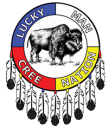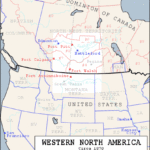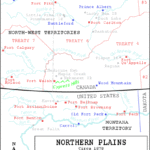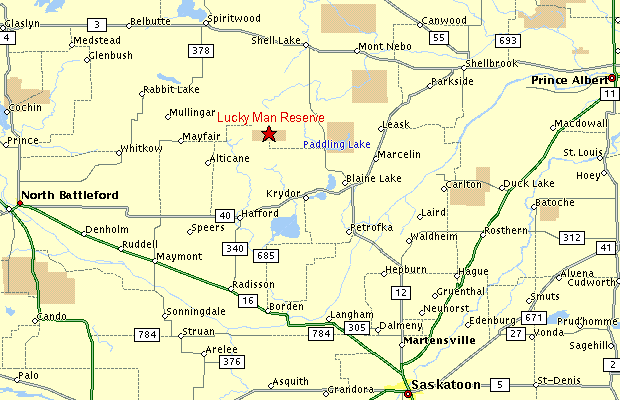Lucky Man Cree Nation - Band History
PAPEWES (Papaway, Lucky Man), chief of a band of the River people, a Plains Cree group; b. in the late 1830s, probably near Fort Pitt (Sask.); d. 1901 near Fort Assiniboine, Mont.
Lucky Man was a headman in the band of Big Bear [Mistahimaskwa*] in the 1870s. During the first part of the decade a number of Plains Cree signed treaties with the Canadian government, but Big Bear did not. He tried to negotiate better terms which would provide a territory for the Cree large enough to protect their autonomy. In these efforts he was supported by Lucky Man. The government refused to revise the treaties, and in an attempt to undermine the leaders who had not signed, exploited the fact that from 1879 the buffalo were no longer to be found in Canadian territory: it simply refused to provide food to starving people who had not taken treaty. In an endeavour to weaken further the influence of those leaders who wanted treaty revision, it also promised to recognize as chief any Cree man who could get 100 people to enter treaty. The policy appeared to work, for in 1879 Lucky Man was selected by 409 members of Big Bear’s band to lead them into Treaty No.6.
Lucky Man and his band took treaty to get food. They did not abandon Big Bear’s leadership, and they remained in the Cypress Hills with him. When he went south to hunt in the United States, Lucky Man went along. When the American army escorted the Cree back to Canada in 1881, Lucky Man and his people returned. Later that year Little Pine [Minahikosis*], Payipwat, and other Cree leaders who supported treaty revision attempted to establish a de facto Indian territory in the Cypress Hills by requesting contiguous reserves, and Lucky Man was present at the meeting. Ottawa, seeing what the Cree had in mind, refused to survey reserves in that area. Instead the government again resorted to starving them into submission. In 1882 it cut off assistance to them unless they moved out of the Cypress Hills. After a year of severe hunger, in 1883 Lucky Man and his band agreed to go to the Battleford district and select a reserve site there. It soon became obvious that the band was just a convenient means for some of Big Bear’s people to get assistance. When Big Bear finally took treaty late in 1882, and agreed to move north the next year, Lucky Man’s band shrank drastically. Its membership dropped from 872 in 1882 to only 85 in 1885. Although some people joined the new militant leader Little Poplar, most returned to Big Bear. Even the government no longer had use for Lucky Man; in 1883 he was deposed as chief because of an attempt he made to return to the Cypress Hills.
In the Battleford region Lucky Man continued to work closely with Little Pine, Big Bear, and Poundmaker [Pītikwahanapiwīyin*] to promote treaty revision. He joined with these Cree leaders in 1884 to ask for contiguous reserves, first at Buffalo Lake (northwest of Stettler, Alta), and, when this request was refused, in the Eagle Hills (Sask.). He assisted Big Bear that year in organizing a major Thirst Dance at Poundmaker’s reserve, and participated in a council of Cree leaders at Duck Lake. Both meetings were to discuss treaty revision. His loyalty to Big Bear continued throughout the winter of 1884–85, which he spent at Frog Lake (Alta) in Big Bear’s camp. He was in the camp when Little Poplar, Āyimisīs (Imasees), and Wandering Spirit [Kapapamahchakwew*] took over leadership of the band and, on 2 April, murdered nine white men who happened to be there. Lucky Man and his son remained with the band through its capture of Fort Pitt in mid April and the initial attacks against it by Major-General Thomas Bland Strange*’s forces late in May. Then, in early June, when Big Bear’s followers dispersed, Lucky Man successfully led 26 of his followers to the United States. En route, one of the young men killed George McIvor, a recent immigrant, near Saskatchewan Landing in a bungled attempt to trade a gun for McIvor’s row-boat. The murder resulted in Lucky Man’s exclusion from the amnesty granted in 1886 to most Indian participants in the violence of the previous year.
Lucky Man was one of many Cree from Frog Lake who fled to the United States in fear of prosecution for their actions in 1885. These refugees were destitute, and by the mid 1890s the American authorities wanted to be rid of them. They threatened to use troops to drive the impoverished Cree back to Canada if they did not leave voluntarily. Lucky Man did return to Canada in 1896 but was met at the border, arrested, and thrown into jail for the murder of McIvor. He was not convicted of the crime, and when he was released in 1897, he immediately went back to the United States, where he died in 1901.
The Gathering At The Signing Of Treaty Six - 1876
Prior to 1860 life for the Plains Cree was prosperous and rewarding. Through a number of campaigns and fluctuating alliances with various other plains Indians (Assiniboines, Blackfoot, Crow, Flatheads), the Plains Cree were able to expand their wealth and territory. During the 1860's, however, they became increasingly concerned about the impact of white culture and non-Indians upon their prime staple, the plains bison. As a result, the Plains Cree became wary of impending government sponsored surveys and development and demanded that all projects cease until a Treaty was signed.
Treaty 6 was signed in 1876 by many of the Plains Cree and the Government of Canada. Absent from this treaty were the large and powerful River People band of the Saskatchewan River area. Unlike other Plains Cree who signed either Treaty 4 (Qu'Appelle River area) in 1874, Treaty 6 or Adhesions to Treaty 6 in 1877 and 1878, many of these River People Cree continued to exist outside the treaty.
During this period, followers of Big Bear and Little Pine, part of the River People, continued to spend most of their time within the game rich Cypress Hills. Because of the area's small size and heavy hunting pressure from Indians and whites alike, the supply of game in this area dwindled quickly. Before the total collapse of game, these Cypress Hills Plains Cree began to lobby for a more equitable treaty.
By the time a meeting was arranged to deal with the potential force of the Plains Cree and their demands, widespread starvation and sickness ran rampant throughout the bands. In view of the weakened state of the Indians, the Lieutenant Governor of the N.W.T. refused to alter the treaty.
As the summer of 1879 came and passed, the buffalo did not return to any of the traditional Canadian areas. To avoid starvation, Little Pine and many of the Big Bear's followers signed an adhesion to Treaty 6 at Fort Walsh on July 2nd, 1879. Twenty-five lodges chose Lucky Man, a headman in Big Bear's band, to represent them at the signing. Few Plains Cree now lived outside of a treaty.
The Role of Lucky Man
Lucky Man was not perceived by white historians as a major force within Plains Cree society. No written mention of his name is made prior to the signing of the 1879 Adhesion to Treaty 6. This, of course, does not mean that within Plains Cree society Lucky Man was of minor stature.
We do know that Lucky Man was a headman in Big Bear's band of River People. Since he was not related to Big Bear, to gain his status, Lucky Man was required to have displayed individual action warranting special consideration. Because no records have been kept of his military prowess, it would appear that Lucky Man gained status through other attributes. Considering that some of Big Bear's Cree decided to sign Treaty 6, someone with the experience of peace making and negotiation would be a logical candidate as leader. In addition, a leader who could still find the buffalo and prolong the traditional ways would also be a desirable choice. Plains Cree society had traditionally placed emphasis upon leaders who could respond to these needs. At the same time, during the troubled times of 1878 and 1879, many viewed treaty signing and the subsequent annuity payments as their only recourse to survival. Big Bear, their previous chief, had not responded according to their wishes. Therefore, in the tradition of Plains Cree society, twenty-five lodges of Plains Cree (470), including 4 headmen, broke with Big Bear and chose Lucky Man as their new chief.
Therefore, it would appear that those who moved to Lucky Man did so because of his leadership qualities. This reaction by the Plains Cree was typical of their ability to rally behind a new leader to meet new external pressures.
By 1880, Lucky Man was referred to, by the Indian Agent at Fort Walsh, as a principal chief along with Piapot and Little Pine. It appears that Big Bear's power had been dramatically reduced as more of his band joined Lucky Man. For instance, in 1880, 754 Indians were recorded in Lucky Man's annuity list. Of this number, 116 were drawing annuity for the first time (i.e., likely Big Bear followers). In addition, however, 188 other recipients, who had previously received payment under other chiefs, were recorded as part of Lucky Man's band. This would suggest that followers of other bands also viewed Lucky Man as a major alternative leader.
During this period, Lucky Man lead his people, along with Little Pine and Big Bear, into the Milk River area of the United States to continue to hunt buffalo. By 1882, however, the annual hunt could no longer be undertaken because of the demise of the buffalo and restrictions upon movement into the United States. In view of the desperate food situation, additional members of Big Bear's band joined Lucky Man to take annuity payment.
Lucky Man's following was now at its highest. Estimates ranged up to 1,200, including non-treaty followers. Lucky Man's status was significant in 1882 when he was recorded as one of the major chiefs to witness Big Bear's signing of Treaty 6. Indian Agent Allen had already noted that he was "viewed with anxiousness". (Allen, 1880).
In the spring of 1883, Lucky Man and the other chiefs were advised that they had to move away from Fort Walsh. No choice was available. In addition, the apparent policy of forcing the Indians to scatter to the north was part of a specific plan to disrupt the large unsettled Cree population of some 2,500 near the U.S. border in the Cypress Hills. Since Lucky Man wished to continue to roam the south and represented the largest segment of this group, it would stand to reason that the more Lucky Man could be discredited and his followers lured away, the greater would be the success of the government policy of minimizing potential insurgence along the international border.
After moving north, Lucky Man tried to return to the Cypress Hills a short time later. He was forced under police escort to return to Battleford and was punished by the Government for attempting to return to the Hills. For instance, he was paid during treaty payment as a member, not a chief, of his band. At these payments, 366 were recorded as members of Lucky Man's band in 1883. In addition, it appears that many other Plains Cree had congregated at Fort Pitt with Big Bear to support a one reserve concept for all Indians. This would account for the major influx of Lucky Man and his band to Big Bear in 1883. In effect, the Lucky Man band had been split in 1883 as Lucky Man traveled to Pitt with Big Bear. This seasonal splitting of bands was not unusual as exemplified by Big Bear's band signing treaty at two different locations.
In the following year, 1884, the number of band members on the paylist dropped to only 82. In 1884, no record was made of any payment to Lucky Man with his band. Rather, Lucky Man was paid as an "ex-chief" with Big Bear in 1884.
Perhaps, however, the reality of the situation was not that Lucky Man's people had deserted him but that they had actually followed him to Big Bear's camp. This would fit with the objective of Big Bear, Lucky Man and Little Pine to form one large reserve, a request repeatedly made in 1883-85. Also, the fact that the Lucky Man followers took payment with Big Bear did not necessarily mean 'that they had abandoned Lucky Man. Rather, they were in desperate circumstances and required the annuity payment to survive. Whether they received it at Fort Pitt under the Big Bear band name or at Battleford under the Lucky Man band name was not of consequence to them during these troubled times. The fact remains that the majority of Lucky Man band members were still with their chief. Further, it should be remembered that Lucky Man moved frequently between Fort Pitt and Battleford. If Lucky Man had joined Big Bear and given up his Chieftainship, then surely he would have been designated his old status of headman. Since Big Bear was the Chief of the visited band, Lucky Man could not also assume that title for purposes of annuity payment without reducing Big Bear's status. Throughout, it should be kept in mind that the removal of Lucky Man as chief would fit with Government policy to reduce Plains Cree cohesion, was made unilaterally by the Government and never confirmed by the band.
From a government perspective, the power of Lucky Man appears to have been broken in 1884. He was still very active, however, in the deliberations of the chiefs of the Battleford area. For instance, during the preparation of the Battleford Council in May 1884, Lucky Man was -present with the other chiefs in organizing this attempt to re-negotiate the Treaty. Throughout the remainder of 1884 and early 1885, Lucky Man met with Poundmaker, Big Bear and Little Pine and moved with his people between Poundmaker's reserve and Buffalo Lake (where Big Bear eventually settled). During Lucky Man's stay with Poundmaker in the summer of 1885, the Government attacked the Indians at Cut Knife Creek on Poundmaker's reserve. To avoid arrest, Lucky Man fled south to the United States with 26 of his followers.
Lucky Man remained in the United States for 11 years, wandering over the countryside. By 1896, the Americans threatened to use force to round up the wandering Cree. Therefore, the Cree returned to the border where a police escort met them. Lucky Man, along with Big Bear's son, Little Bear, were treated as rebels and placed in prison. Once released, Lucky Man again fled to the United States where some of his band had again relocated to avoid Canadian Government retribution. Lucky Man died in the United States during the early 1900's.
The traumatic impact of the abandonment of a way of life upon any culture cannot be underestimated. Clearly, for the Plains Cree who were a major military and cultural force as late as 1870, the events of the early 1880's must have been tumultuous.
For all of Lucky Man's effort and important guiding role, his place in history has been obscured. It is possible that the events of history could have been altered if Lucky Man had remained with Big Bear and not signed Treaty 6 in 1879. For instance, it has been noted that Big Bear, under the influence of Little Popular, was a serious threat to stability in the area because of his vocal opposition to the conditions of Treaty 6. It would appear that much of Big Bear's inability to obtain treaty concessions was his lack of band members due to their transfer to Lucky Man. Whether intended or not, Lucky Man was a stabilizing force in the transfer of Plains Cree out of a nomadic life.
Unfortunately, the Rebellion of 1885 disrupted any potential smooth transition of Lucky Man from a leader of a wandering band to a settled reserve chief. Through persecution prior to the rebellion and as a consequence of it, Lucky Man seems to have been denied the status of chief and continued rightful leader of his band.
Implications for Present Day
Much of the written historic record remains absent. Yet, the role of Lucky Man and the impact he had upon the settlement of the West should not be underestimated. Review of those records shows unequivocally the importance of Lucky Man and his Band. Yet, through apparent Government manipulation and the destitute state of many Plains Cree, the Lucky Man Band was denied its full treaty entitlement. In so doing, many Treaty Indians were poorly served and ultimately denied their Treaty rights. The following discussion examines the resulting injustice.
Lucky Man Reserve Selection
Following his signing of Treaty 6, Lucky Man remained In the Cypress Hills, later setting out for the Missouri River country to once more hunt buffalo. In the spring of 1880, Lucky Man returned to Fort Walsh and made camp in the Cypress Hills with Big Bear. During this period, Lucky Man and the two other major non-reserve chiefs, Little Pine and Big Bear watched how their fellow Cree were adapting to reserve life. Evidence existed that several such as Piapot and Poundmaker were dissatisfied.
Even so, by 1881, the situation was desperate at Fort Walsh where, in combination with the disappearance of game, the government indicated its unwillingness to distribute future annuity payments. At this time, Lucky Man requested a reserve at Big Lake, 30 miles from Fort Walsh. Although no further record exists of this area, there is evidence that Lucky Man had indicated a preference for a reserve to the Government and that he was willing to seek out a 4ocabon. It is interesting to note that oral history of the Lucky Man and Little Pine Band reveals the evidence that Lucky Man did select a reserve which he later lost (Lucky Man and Little Pine Elders, 1977).
As was the case with other Cree bands, such as Piapot and Poundmaker, Lucky Man attempted to remain within the Cypress Hills for as long as possible. He was eventually forced to relocate in the area near Battleford. Because of his wanderings, Lucky Man received a major dishonour, when he was removed as chief of his band by the government. Considering the fact that the Indian budget was cut for farm instruction, education and annuity payments between 1881-84 at a time when more Indians were being added to the Treaties, it is no wonder that Lucky Man was not anxious to settle on another reserve.
Even so, Lucky Man again requested a reserve in 1884 in an area adjacent to Poundmaker, Little Pine and Big Bear. The Government, fearing complications from such a joint association, refused. Little Pine, who selected his reserve at its present site, began to receive rations. Meanwhile, Lucky Man appears to have refused to move onto a reserve in isolation from Big Bear and the other chiefs. As a result, some of Lucky Man's followers began to join other settled bands where rations were provided and winter supplies were more accessible.
It appears that the Government was intent upon forcing the Little Pine and Lucky Man bands upon one reserve. Thus, the Lucky Man band members who were at Battleford moved onto the Little Pine Reserve. This was probably a temporary measure to gain food rations and prevent hunger. Meanwhile, the larger segment of the Lucky Man Band was at Fort Pitt with Lucky Man and Big Bear. Unfortunately, before Lucky Man could select a reserve, the rebellion destroyed any opportunity of Lucky Man reuniting his people.
Therefore, by the time the Little Pine Reserve was surveyed by Nelson in 1887, the rest of the original Lucky Man members had disbanded or were south in the United States. Only seven Lucky Man members remained on Little Pine. Of these seven, no headmen were present. It is clear, then, that by the time Nelson surveyed a reserve for the Little Pine and Lucky Man bands, no representation on behalf of the Lucky Man Band could be made.
This combination of the Little Pine and Lucky Man Bands onto the Little Pine Reserve does not mean that the Lucky Man treaty obligation had been met. Rather, it represents an inaccurate judgement by Surveyor Nelson, followed by an improper Order-in-Council PC1 151 in May of 1889, both of which incorrectly set aside a joint reserve.
Current Situation
As a result of perseverance by the Band, a Reserve of 7,680 acres, based upon the Band December 31, 1980 population, was selected by the Lucky Man Band northwest of Saskatoon (Map 1). Confirmation of transfer occurred in November 1989. While the Band continues to believe that it deserves additional acreage to properly address its original adhesion to Treaty 6, it intends to examine land use options for the selected land.











